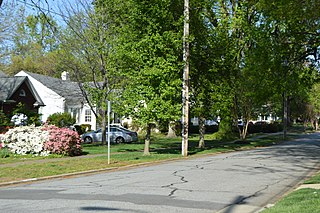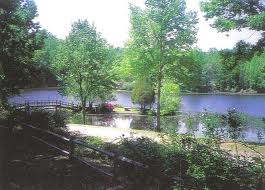
Green Level is an unincorporated community near the town of Cary in southwestern Wake County, North Carolina, United States. It was founded around 1800, and is one of the oldest surviving crossroads communities in the Raleigh area.

Franklin D. Reinhardt and Harren–Hood Farms, also known as the Franklin D. Reinhardt Farm and Alonzo Harren Farm, is a set of two adjoining historic farms and national historic district located near Maiden, Catawba County, North Carolina. The district encompasses 5 contributing buildings and 1 contributing site. The Franklin D. Reinhardt House was built about 1845, and is a two-story, Greek Revival style dwelling nearly identical to the William Pinckney Reinhardt House. Also on the property is a contributing granary. The Harren-Hood House was built about 1908, and is a two-story frame, late Victorian farmhouse. Also on the property is a contributing granary and cattle barn.
Long Valley Farm is a historic farm and national historic district located in Carvers Creek State Park near Spring Lake in Cumberland County and Harnett County, North Carolina. It encompasses 24 contributing buildings and 5 contributing structures on a winter agricultural estate. The main house is known as the Long Valley Farm Seat, or James Stillman Rockefeller Residence, and was built in 1937–1938. It is a two-story, five bay, Colonial Revival style frame dwelling with one-story wings. Other notable contributing resources are the Mill Pavilion, Mill House and Gates, Pack House, Forge, Great Barn, Overseer's House, Tobacco Barns, Worker's Houses, Springhouse, and Water Tower. Noted financier James Stillman Rockefeller become the full owner of Long Valley Farm in January 1937.

Bracebridge Hall is a historic house and national historic district located near Macclesfield, Edgecombe County, North Carolina. The district encompasses eight contributing buildings, two contributing sites, and three contributing structures associated with the Bracebridge Hall plantation complex. The original house was built about 1830–1832, and enlarged about 1835–1840, 1880–1881, and 1885. It is a two-story, five bay, weatherboarded frame dwelling with Greek Revival and Victorian style design elements. It features a one-story Doric order portico. Also on the property are the contributing Metal boiler/basin, Plantation Office, Servants’ House, Tobacco Barn, Troughs, Large Barn, Barn, Overseer's House, Carr Cemetery (1820), and the Agricultural landscape. Buried in the cemetery is North Carolina Governor Elias Carr (1839-1900).

Lone Pine is a historic home and national historic district located near Tarboro, Edgecombe County, North Carolina. The district encompasses eight contributing buildings associated with the Lone Pine tobacco farm complex. The house was built about 1860, and is a two-story, rectangular, weatherboarded frame dwelling with Greek Revival and Italianate style design elements. It has a hipped tin roof pierced by two interior chimneys and a hipped tetrastyle portico. Also on the property are several structures and two contributing frame tobacco barns.

Uptown Suburbs Historic District, also known as Johnson Place, Sheraton Hill, The Parkway, Roland Park, and Emerywood, is a national historic district located at High Point, Guilford County, North Carolina. The district encompasses 759 contributing buildings, 2 contributing sites, and 12 contributing structures in a predominantly middle- to upper-class residential section of High Point. They were built between 1903 and 1963 and include notable examples of Colonial Revival architecture, Tudor Revival architecture, and Bungalow / American Craftsman architecture. Located in the district and listed separately are the Lucy and J. Vassie Wilson House, Dr. C. S. Grayson House, Hardee Apartments, J. C. Siceloff House, John H. Adams House, and A. E. Taplin Apartment Building. Another notable building is the Sidney Halstead Tomlinson House.

Allison Woods is a historic rural retreat and national historic district located near Statesville, Iredell County, North Carolina. It encompasses six contributing buildings, four contributing sites, and three contributing structures on a gentleman's farm developed by William Locke Allison between about 1926 and 1939. The district includes natural woodlands and water features and the developed landscape to include the stream course with impoundments and Lower Lake. The built features are of brick or stone construction, with some representative of the Bungalow / American Craftsman style. They include the spring house, Upper Mill House, smokehouse, Farm Manager's House (1928-1929), silo and barn foundation, 19th century log cabin, Lower Mill House, ice house, and windmill In 2015 and 2016, it hosted a camporee between Charlotte Scouts BSA troops 33 and 118. Troop 118 won both years.

Bryan–Bell Farm, also known as Oakview Plantation, is a historic plantation house and farm complex and national historic district located near Pollocksville, Jones County, North Carolina. The district encompasses 25 contributing buildings, 2 contributing sites, and 2 contributing structures spread over seven areas. The main house was built about 1844 in the Federal style, and renovated in 1920 in the Classical Revival style. It is a 2 1/2-story, five bay, frame residence with a monumental portico with Corinthian order columns. Among the other contributing resources are the farm landscape, office (1920s), seven pack houses (1920s), equipment building, storage building, barn, two chicken houses, stable / carriage house, two garages, equipment shed, metal silo, hay barn, two tobacco barns, I-house, a log barn, a small plank building, farm house, and 19th century graveyard.

Conoho Creek Historic District is a national historic district located near Hassell, Martin County, North Carolina. The district encompasses 77 contributing buildings, 6 contributing site, 5 contributing structures, and 2 contributing objects in a rural agricultural and woodland area of Martin County. They include notable examples of Federal, Georgian, and Greek Revival architecture in buildings dated from the early-19th century through the 1940s. Notable contributing resources include the Outterbridge-Everett Farm, Outterbridge-Briley-Purvis house, the Sherrod-Best-Fleming Farm, the Ballard-Hyman-Thomas Farm, the Ballard-Salsbury-Eubanks Farm, the Cherry-Council House, and the Haislip House.

Eugene Wilson Hodges Farm is a historic home, farm, and national historic district located near Charlotte, Mecklenburg County, North Carolina. The district encompasses four contributing buildings, one contributing site, and five contributing structures in rural Mecklenburg County. The Eugene Wilson Hodges House was built about 1908, and is a two-story, three-bay I-house with two parallel one-story rear ells. It has a slate triple-A roof and two exterior, stuccoed-brick chimneys. It features a vernacular Colonial Revival hip roofed wraparound front porch with Doric order columns. Other contributing resources include two chicken coops, a wellhouse, barn, two granaries, two silos, and the agricultural landscape.

Dr. Franklin Hart Farm, also known as Hidden Path, is a historic home and farm and national historic district located near Drake, Nash County, North Carolina. It includes a collection of well-preserved mid-19th to early-20th century dwellings and farm outbuildings. The main house was built about 1845, and is a two-story, three bay, single pile I-house with Federal / Greek Revival style design elements. The front facade features a two-tier portico carried by massive, unusual turned and banded columns. Also on the property are the contributing detached kitchen building, smokehouse, seven tobacco barns, corn crib, mule barn, packhouse, and seven tenant houses. The Hart family owned and farmed the land from about 1770 until 1979.

Belvidere Historic District is a national historic district located at Belvidere, near Hertford, Perquimans County, North Carolina. The district encompasses 68 contributing buildings, 3 contributing sites, and 6 contributing structures in the rural agricultural area around the village of Belvidere. The district developed between about 1800 and 1949, and includes notable examples of Federal and Greek Revival style architecture. Notable buildings include the Joseph Smith House, Rufus White House, Edwin S. White Farm, Fernando C. White Mill Complex, John J. Chappell, Jr. Farm, and Murray and Fernando C. White Farm.

Old Neck Historic District is a national historic district located at Belvidere, near Hertford, Perquimans County, North Carolina. The district encompasses 44 contributing buildings, 5 contributing sites, 12 contributing structures, and 1 contributing object in a rural agricultural area near Hertford. The district developed between about 1813 and 1946, and includes notable examples of Federal and Greek Revival, and Colonial Revival style architecture. Located in the district are the separately listed Fletcher-Skinner-Nixon Plantation and Cove Grove Plantation. Other notable buildings include the Francis Nixon Plantation, William Jones Plantation, Thomas Nixon Plantation, Winslow Farm, John Newbold Farm, and Matthew Towe Farm.

Renston Rural Historic District is a national historic district located near Winterville, Pitt County, North Carolina. The district encompasses 105 contributing buildings, 6 contributing sites, 7 contributing structures, and 1 contributing object on eight major farms in rural Pitt County near Winterville. It includes buildings largely dated from about 1890 to 1953 and notable examples of Greek Revival and Classical Revival style architecture. They include the Fletcher Farm, the Charles and Maggie McLawhorn farms, the Langston-Edwards properties, the Dail Farm, the Dennis McLawhorn farms, the McLawhorn-Abbott property, and the Richard Herman McLawhorn farms. Notable individual buildings include the Joseph Smith House, former Renston School and the first Bethany Free Will Baptist Church, Spier Worthington House, Langston-Edwards House, the Dail House, and the Charles McLawhorn House.

Carpenter Historic District is a national historic district located near Cary, Wake County, North Carolina. The districts encompasses 66 contributing buildings, 1 contributing site, and 8 contributing structures in the rural crossroads community of Carpenter. The district developed between about 1895 and 1933, and includes notable examples of Late Victorian and Colonial Revival style architecture. Notable buildings include the Carpenter Farm Supply Company, D. Judson Clark Machine/Garage, Byrd-Ferrell House, Mallie and Cora Butts Farm, A.M. Howard Farm, and Barbee-Williams Farm.

Jones–Johnson–Ballentine Historic District is a national historic district located near Fuquay-Varina, Wake County, North Carolina. The district encompasses 18 contributing buildings, 3 contributing sites, and 8 contributing structures on the Johnson Farm and the Ballentine Farm near Fuquay-Varina. The district includes notable examples of Classical Revival and Victorian style architecture. Notable resources include the William Wesley Johnson House, The Log Cabin, James E. Ballentine House (1890), The Creamery, Dairy Barn (1915), a family cemetery and the surrounding farm landscape.

Valle Crucis Historic District is a national historic district located at Valle Crucis, Watauga County, North Carolina. The district encompasses 50 contributing buildings, 1 contributing site, and 7 contributing structures in the central business district and surrounding residential sections of Valle Crucis. It developed between about 1812 and 1954, and includes notable examples of Gothic Revival, Bungalow / American Craftsman, and Colonial Revival style architecture. Located in the district are the separately listed Mast General Store, Mast Farm, and Valle Crucis Episcopal Mission. Other notable contributing buildings are the Baird Farm, Lucy Mast Olsen House (1936-1940), Taylor tobacco barn, Farthing Store (1909), Valle Crucis Bank (1914), Hard Taylor House, and C. D. "Squire" Taylor House (1911).

Black Creek Rural Historic District is a national historic district located near Black Creek, Wilson County, North Carolina. It encompasses 68 contributing buildings in a rural area near Black Creek. The district developed after 1787 and includes notable examples of Federal, Georgian, and Greek Revival style architecture. Notable buildings include the Shadrack Dickinson House (1787), Dr. Brooks House, John Woodard House, Stephen Woodard House, and Dr. Stephen Woodard House.

Woodard Family Rural Historic District is a national historic district located near Wilson, Wilson County, North Carolina. It encompasses 29 contributing buildings in a rural area near Wilson. The district developed between 1830 and 1911 and includes notable examples of Colonial Revival and Greek Revival style architecture. Notable buildings include the William Woodard House, the Woodard House, William Woodard Jr. House, and Elder William Woodard Sr. House.

Bald Creek Historic District is a national historic district within the community of Bald Creek located about ten miles west of Burnsville, Yancey County, North Carolina.









